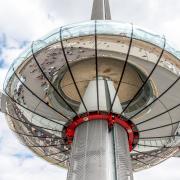When the ‘shout’ comes Sarah Huntley and Emily Summerfield scramble to Brighton Marina, desperate to join the rest of the Brighton Royal National Lifeboat Institution crew. The women are sisters and between them they’ve helped rescue countless lives.
Saving those in peril at sea is in their blood. Their dad, Paul, 76, was a RNLI volunteer in Eastbourne for 20 years, and Sarah, 39, and Emily, 36, grew up knowing that he was a real-life hero.

‘It was totally normal for Dad’s pager to go off in the middle of the night and off he’d rush to help save lives at sea,’ Emily says. ‘We thought it was all really exciting and it was those memories that inspired us to join.’
Emily was working as a constable with Sussex Police when she moved from Turners Hill to Ovingdean, near Brighton, four years ago. Even though she’d just had a baby girl, Maddie, who was a year old, now that she was on the coast she saw her chance to follow in her father’s footsteps. ‘I’d always been interested in the RNLI because of Dad and had just had my daughter but I jumped at the chance to become involved in September 2019,’ she says. Two years later, the trainee crew member had her son, William, now two.

She’s now been joined by her sister. Sarah, a performance and sports psychologist, and a Wim Hof cold water immersion trainer and mountain leader, who also lives in Ovingdean, volunteered in January 2023, and only has two more assessments before she’s the fourth seat in the boat.
Now the sisters, who look so alike they are constantly mistaken for each other, face danger on an almost daily basis leaving their families at home to risk their own lives rescuing others. They are part of a mostly female crew at Brighton’s lifeboat station, the first in Britain to be LGBTQ+ accredited providing a 24/7 on call search and rescue service on Random Harvest, the station’s only lifeboat, an Atlantic 85, which plies the Sussex coastline between Newhaven and Shoreham.
It’s a far cry from when the RNLI first began, 200 years ago this month on 4 March, when women weren’t even allowed on the boat. Their only role would have been to look after the family while waiting for their men to return. In fact, it wasn’t until 1969 when the first woman qualified to command a lifeboat. Now nearly one in eight of all volunteer crew members are women.

Back then the lifeboats were wooden, and relied on sails, oars, volunteers and donations to keep it running since it was founded by Sir William Hillary in 1824. Living in Douglas on the Isle of Man, Hillary saw the treacherous nature of the sea first-hand. He witnessed dozens of shipwrecks and saved many lives with the help of locals. In the early 19th century, there was an average of 1,800 shipwrecks a year around our coasts. Rescue services did exist in some places, but the danger of shipwreck was an accepted way of life at sea. Hillary, however, vowed to take action and the RNLI was born (though it was initially called the distinctly uncatchy National Institution for the Preservation of Life from Shipwreck).
Since then the crews have saved 144,000 lives nationally – including during WW1 and WW2 when 19 lifeboats helped in the Dunkirk evacuation - but while the technology on board modern all-weather power lifeboats is state-of-the-art, the organisation still relies on brave volunteers and funds to save lives at sea.
Now the institution is celebrating its bicentenary with a programme of activities across the country and county, including a special service of thanksgiving on the RNLI’s 200th birthday, 4th March 2024. The cost of running the RNLI in 2022 was £188 million with 81p of every £1 raised funds lifesaving activities with the remainder used to generate more funds.

RNLI Chief Executive, Mark Dowie, says: ‘It has been an honour and a privilege to be at the helm of the RNLI for approaching five years, and to see the charity reach its bicentenary. For a charity to have survived 200 years based on the time and commitment of volunteers, and the sheer generosity of the public donating to fund it, is truly remarkable.
‘In 2024, we mark the bicentenary of the RNLI. We remember the achievements and commitment of all those who have been part of the RNLI family over the past two centuries; we celebrate the worldclass lifesaving service we provide today, based on our 200 years of learning, expertise and innovation, and we hope to inspire future generations of lifesavers and supporters who will take the RNLI into its next century and beyond.’
For more information on the RNLI’s 200th anniversary, or to donate, visit RNLI.org/200.

Emily’s story: ‘Dad inspired me to join the RNLI’
The mother of two, who investigates fraud and money laundering for AMEX, is part of the mostly female RNLI crew at Brighton
‘Volunteering for the RNLI was almost inevitable for me. I was a police officer – a constable - with Sussex police until last year and have two children, a five-year-old girl and a two-year-old boy, so I was busy but my dad was with the RNLI for around 20 years.
He was launch authority, in charge of deciding whether to page and launch, and the sea safety advisor, reviewing people’s boats and their equipment to ensure that everything was seaworthy. Dad was always in to boats and saw joining the RNLI as a way of repaying the personal luck he’d had. He’s in his mid-70s now, and still just as adventurous; he’s currently in Antarctica on a cruise. He joined when I was about ten and it inspired me to be part of it too.
‘I admit I’m a bit of an adrenaline junkie and I feel lucky to be able to do it in a lifeboat. It’s such a good cause too, to be there as a rescuer. It’s remarkable how happy people are to see my uniform rather than my old one. We have a great team in Brighton. Everyone gets on really well and whoever turns up for a particular ‘shout’, well, you know you’re in safe hands. We have highly qualified people in their chosen fields, such as paramedics, and we’re always prepared.
We’re particularly lucky in Brighton where we’ve had a female heavy crew compared to the national average. It’s probably just the demographic of the area, which is very accepting, but I love it. It can be hard but anything I can do to help save a life at sea makes it worth it. I’m so glad Sarah, my sister, is part of the crew too. She’s the right person to have in the boat. I know Dad is very proud of us.’
RNLI: The numbers
506 lives were saved by the RNLI in 2022 while 39,680 souls were saved.
140 people die annually in UK and Irish coastal waters and the RNLI’s vision is to save every one.
238 UK and Irish lifeboat stations cover 19,000 miles of coastline with 441 lifeboats (including relief fleet vessels) and seven hovercraft, while RNLI lifeguards patrol 240 UK and Channel Island beaches.
8 RNLI lifeboat stations operate in Sussex at Brighton, Eastbourne, Hastings, Littlehampton, Newhaven, Rye, Selsey and Shoreham.



























